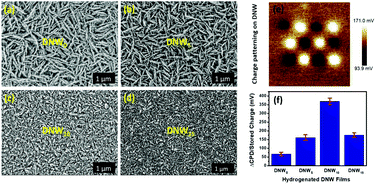Hydrogenation of diamond nanowire surfaces for effective electrostatic charge storage†
Abstract
We report a novel versatile method for writing charged areas on diamond nanowire (DNW) surfaces using an atomic force microscopy (AFM) tip. Transmission electron microscopy (TEM) investigations revealed the existence of abundant plate-like diamond aggregates, which were encased in layers of graphite, forming nano-sized diamond-graphite composites (DGCs) on DNW surfaces. These DGCs are the main feature, acting as charge-trapping centers and storing electrostatic charge. A hydrogenation process has been observed effectively enhancing the charge-trapping properties of these DNW materials. The effective charge trapping properties with hydrogenation are ascribed to the disintegration of the DGCs into smaller pieces, with an overall increase in the metallic nanographitic phase fractions in a dielectric diamond matrix. Moreover, the written charge on the surface can be easily modified, re-written, or completely erased, enabling application in diamond-based re-writable electronic devices. However, excessive hydrogenation degrades the charge-trapping properties, which is attributed to the etching of the DGCs from the surface. This study demonstrates the potential importance of a simple hydrogenation process in effective electrostatic charge trapping and storage for diamond related nanocarbon materials and the role of DGCs to further enhance it.



 Please wait while we load your content...
Please wait while we load your content...